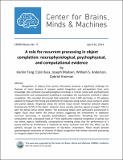A role for recurrent processing in object completion: neurophysiological, psychophysical and computational evidence.
Author(s)
Tang, Hanlin; Buia, Calin; Madsen, Joseph R.; Anderson, William S.; Kreiman, Gabriel
DownloadCBMM-Memo-009.pdf (4.214Mb)
Terms of use
Metadata
Show full item recordAbstract
Recognition of objects from partial information presents a significant challenge for theories of vision because it requires spatial integration and extrapolation from prior knowledge. We combined neurophysiological recordings in human cortex with psychophysical measurements and computational modeling to investigate the mechanisms involved in object completion. We recorded intracranial field potentials from 1,699 electrodes in 18 epilepsy patients to measure the timing and selectivity of responses along human visual cortex to whole and partial objects. Responses along the ventral visual stream remained selective despite showing only 9>25 of the object. However, these visually selective signals emerged ~100 ms later for partial versus whole objects. The processing delays were particularly pronounced in higher visual areas within the ventral stream, suggesting the involvement of additional recurrent processing. In separate psychophysics experiments, disrupting this recurrent computation with a backward mask at ~75ms significantly impaired recognition of partial, but not whole, objects. Additionally, computational modeling shows that the performance of a purely bottom>up architecture is impaired by heavy occlusion and that this effect can be partially rescued via the incorporation of top>down connections. These results provide spatiotemporal constraints on theories of object recognition that involve recurrent processing to recognize objects from partial information.
Date issued
2014-04-26Publisher
Center for Brains, Minds and Machines (CBMM), arXiv
Citation
arXiv 1409.2942
Series/Report no.
CBMM Memo Series;009
Keywords
Object Recognition, Vision, Neuroscience
Collections
The following license files are associated with this item: